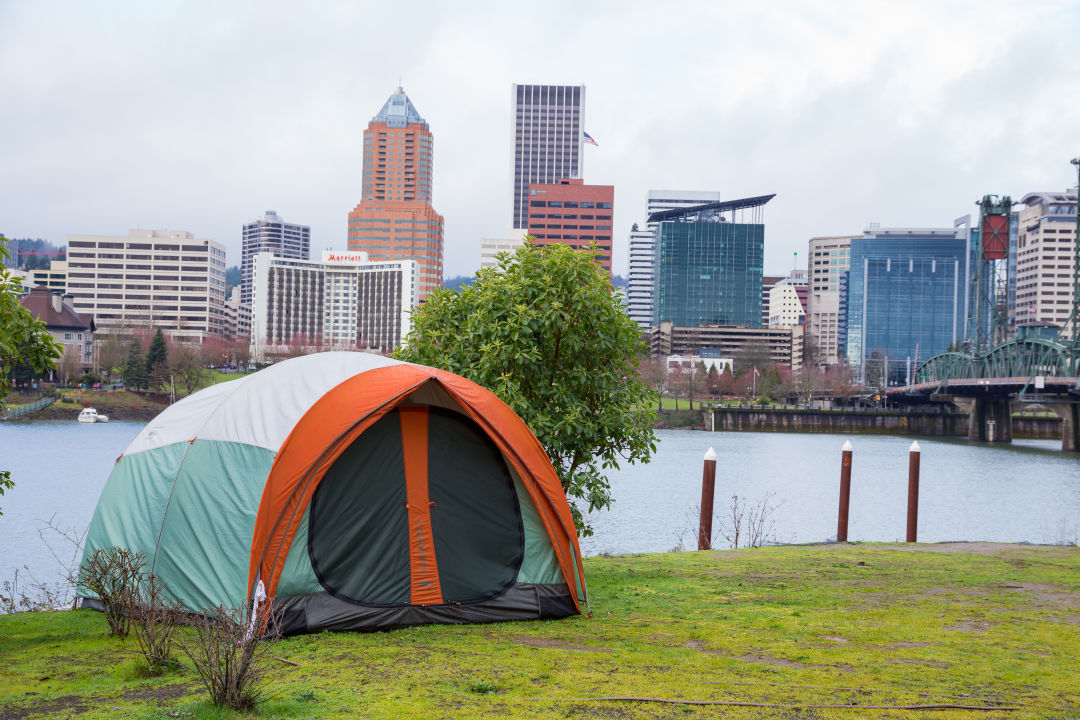Solving Portland's Houselessness Issues Could Start with Zoning

The snow, ice and wind storm that’s knocked out power around the metro Portland area over the last few days has been particularly toxic for the city’s most at-risk residents: those without a permanent home, who had no power to lose in the first place.
Municipal workers and volunteers have scrambled to staff shelters and hand out warm clothes and blankets to those who live on the streets, an effort that’s neither easy nor entirely effective, with some resorting to impromptu fires to stay warm—with dangerous, even deadly results.
Within a few weeks, the Portland City Council is set to consider a series of proposed changes to its zoning regulations to allow more shelter options in more places for more people; a step toward making sure that the next time severe weather brings the metro area to a standstill, fewer people might suffer.
It’s called the Shelter to Housing Continuum, and is the second in a series of consequential zoning changes that the city has considered in the last six months (the first, the Residential Infill Project, allowed for more multi-family homes to be built in residential neighborhoods around the city).
“One of the assumptions underlying this project is that we aren’t adequately dealing with the space that sits between the tent on the street and a single-family home,” says Eric Engstrom, the city planner who has been working on the proposed changes.
In other words, housing doesn’t only mean a picket fence and a mortgage, or an elevator and a rent payment, particularly not in Portland, where tent camping has proliferated in recent years, touching off periodic and charged sweeps of homeless camps at public parks and near schools.
Among the changes under consideration:
- Allowing larger shelters to be built in more places, including in or adjacent to commercial zones, without having to go through a conditional use permitting process, which requires notification of neighbors and public hearings.
- Formally adding an “outdoor” shelter category that builds on the model of the Kenton Women’s Village, which was permitted under a single-use exemption. “This is not a permit that a random group of people can decide to form a village and set up camp,” Engstrom says. “This is public agencies and nonprofits opening supervised facilities with services.” The goal, he says, is to appeal to those in the houseless population that don’t want to be in an indoor shelter, but give them the same access to bathrooms, laundry, garbage removal and supportive services. It could mean that people sleep in small wooden structures, yurts, or even cars and RVs, which currently have to worry about overstaying their welcome when parked on some city streets. (Another model here: the city of Beaverton’s safe parking program, which includes on-site access to storage and garbage removal.)
- Jettisoning the outmoded concept of what constitutes a “household.” Under current city code, residential living is divided into two categories: household living and group living—a family unit in the former, dormitories or retirement communities or monasteries in the latter. The proposed revision gets rid of the definition that a household means those related by blood or marriage, and allows, Engstrom says, “a wider range of people to live together in single-family zones.” That means more flexibility for co-housing developments, where several apartments might share a single kitchen, in what Engstrom calls, ‘a long-term play’—not many people are positioned to build this now.
- Making it legal to have an inhabited RV or a tiny home on wheels be parked in your driveway or on your property, anywhere in the city. Right now, the city has a ban on living in tiny homes on wheels and RVs, but it isn’t enforced. The proposal, if passed, would bring Portland in line with similar programs in Los Angeles and San Diego, though property owners would still need to provide a campground-style hook-up to utilities.
Passing the changes is not an academic exercise, Engstrom says. If the city council declines to adopt the proposals in some form, it’s possible that the makeshift shelters and spaces that have sprung up to provide social distancing during the pandemic will have to shut down, since they are in places that aren’t allowed under existing zoning code, instead permitted by emergency—and temporary—regulations that have been in place since 2015 but are set to expire in April.
The city council is set to hold public hearings on the proposals in March. If they pass, the shelter-related elements would take effect in April; changes to group living and RVs/tiny homes on wheels would be in place by August.
The last time the population was counted, in early 2019, there were more than 4,000 houseless people living in Portland.




